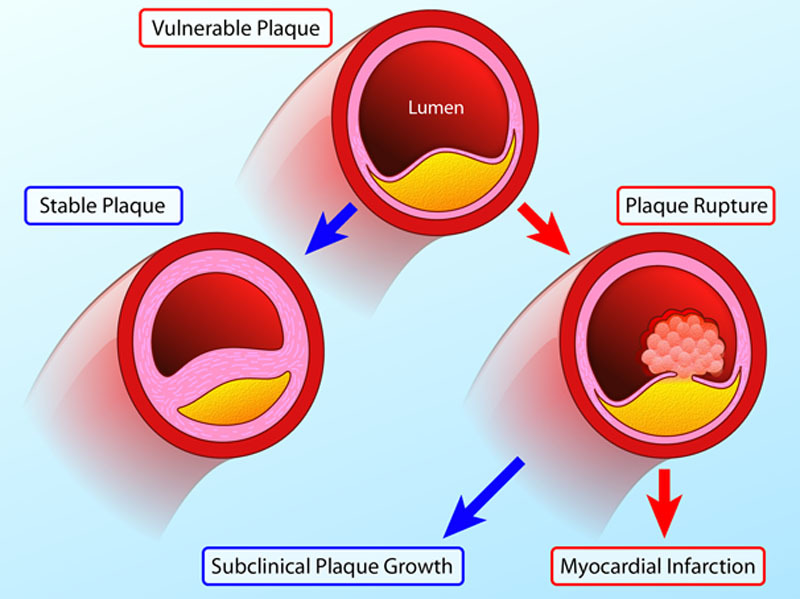Playlist
Show Playlist
Hide Playlist
Abnormal Q Waves: ECGs of Healed Myocardial Infarction (MI)
-
Slides ECG of Myocardial Infarction.pdf
-
Download Lecture Overview
00:01 So, as the myocardial infarct heals, the EKG develops these initial Q waves and usually they stay there. 00:09 Even years later, the Q waves may tell us, “Oh, there was an earlier myocardial infarct in this zone.” Let's say there were Q waves in 2, 3, and aVF and the patient said, “Oh, yes, I had a heart attack 10 years ago.” Those Q waves are still there because there's a scar there. 00:24 There's an electrically quiet zone in the scar that shows the infarct that occurred in the past. 00:31 So with time, the ST elevation comes down. 00:35 It becomes flat again. Usually the T waves then become inverted and as I mentioned, Q waves can persist as a permanent reminder of the old MI and then over time, the inverted T waves usually become upright again. 00:49 So here, how do we know abnormal Q waves? Well first of all, abnormal Q waves are usually going to be less than one little box. 00:59 So less than 0.04 seconds and less than 2 mm in depth. 01:04 So that means there gonna be less than 1 small box wide and less than 2 small boxes deep. 01:13 And here we see an old EKG. 01:15 This is an old inferior MI. Do you see leads 2, 3, and aVF? There are very significant Q waves there wider than 1 little box and particularly in leads 3 and aVF, they're deeper than 2 little boxes. 01:30 So previous inferior MI. 01:32 Also notice here that the T waves are inverted. 01:35 They haven't come back yet. 01:36 Usually with time they will come back. 01:39 So larger Q waves are pathological Q waves. 01:43 They're usually sign of a prior MI and as I said in this EKG, 2, 3, and aVF show an old inferior MI. 01:51 Another example: here we see, again, Q waves. 01:55 It leads 2, 3, and aVF. This is an old inferior MI. 01:59 Notice the green boxes showing you the Q waves. 02:02 There are abnormally inverted T waves there as well. 02:06 And also notice inverted T waves out in V3, 4, 5, and 6 so this tells you that there's some lateral anterior involvement. 02:15 This may very well be a circumflex infarct. 02:19 Cuz circumflex can give you both supply to the posterior wall and also to the lateral wall. 02:27 Q waves in these leads imply that the MI was not just on the back of the heart but also involved possibly some of the anterior and lateral wall. 02:37 Here's another example: here's a Q wave in leads V1, V2, V3. Notice the green boxes. 02:44 There's a small residual amount of ST elevation in these leads so this infarct may have been within the last few weeks or days and there's also inverted T waves in the rest of the anterior leads. 02:59 Again, telling you this is an anterior wall myocardial infarct. 03:04 The computer frequently will read these findings as anterior infarct age indeterminate. 03:11 We don't know when it exactly occurred. It's not acute. It's not just occurring right now. 03:16 It occurred at some point in the past.
About the Lecture
The lecture Abnormal Q Waves: ECGs of Healed Myocardial Infarction (MI) by Joseph Alpert, MD is from the course Electrocardiogram (ECG) Interpretation.
Included Quiz Questions
Which of the following statements about ECG changes that occur with MI healing is false?
- Over time, prominent P waves develop.
- Most ECG leads with ST elevation develop initial Q waves.
- With time, ST elevation becomes flat again, and inverted T waves become upright.
- Q waves can persist as a permanent reminder of the old MI.
- Over time, inverted T waves usually become upright.
Q waves in leads II, III, and aVF indicate which of the following?
- Old inferior MI
- Acute inferior MI
- Acute lateral MI
- Old lateral MI
- Old superior MI
Customer reviews
5,0 of 5 stars
| 5 Stars |
|
5 |
| 4 Stars |
|
0 |
| 3 Stars |
|
0 |
| 2 Stars |
|
0 |
| 1 Star |
|
0 |





